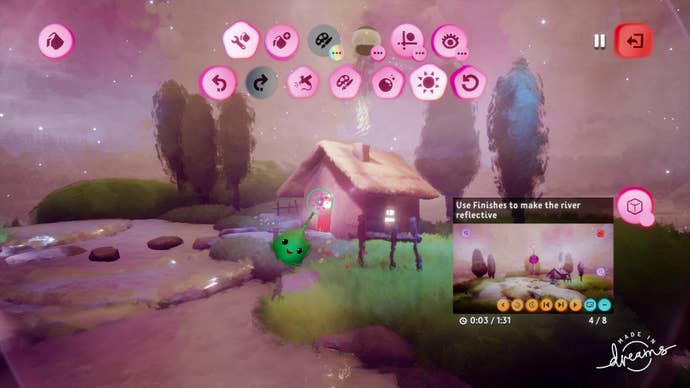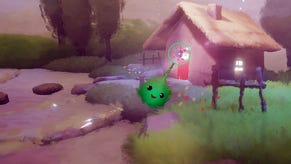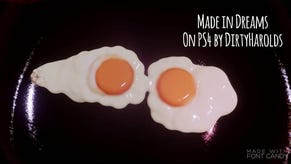Dreams Review: An Endless Arcade of the Mind
Media Molecule wants you to reach into the depths of your imagination and recreate Crash Bandicoot.
This article first appeared on USgamer, a partner publication of VG247. Some content, such as this article, has been migrated to VG247 for posterity after USgamer's closure - but it has not been edited or further vetted by the VG247 team.
With creation games like Dreams, there's always a fear (for me, anyway) that you're looking to other people to fill the creative gaps that your imagination cannot muster. It's like going to the National Portrait Gallery and attempting to paint something from your imagination while surrounded by works that are better than your own. Try as you might to create something, you're nearly always subconsciously looking at other creative works for guidance, or at least helpful vision.
Dreams is a creation tool from Media Molecule. Following in the footsteps of LittleBigPlanet's comparatively smaller creation tools, Dreams provides you with a vast, encompassing studio with which to create theoretically anything. Ranging from smaller mood pieces like a desert island, to full-blown recreations of games like Hollow Knight, Dreams places you at the helm of a supercharged creation engine.
For Media Molecule's Dreams, the "National Portrait Gallery" is best represented by "Art's Dream," the story mode of sorts made by Media Molecule's own designers, and a new addition for Dreams' 1.0 launch out of early access. It's meant to be a showcase of what's possible, guiding you through a bad dream by the narrator, Art. You are represented by a cursor in the game, a colorful Imp, able to push, pull, and press objects around the environment.

The story mode alternates between playing as Art, where the gameplay orients itself around an old point-and-click style adventure game, and playing as Foxy and Frances, two of Art's childhood toys. The former mode is abstract in its storytelling and atmosphere, as Art deals with the trauma of running away from his role as a star double bass player in a band. He confronts his own inner demons, represented by a train running out of control and other not-so-subtle metaphors, as well as painstaking segments where it becomes a full-blown Broadway musical. Art's Dream is where Dreams takes itself a little too seriously, as you wind through Art's story talking to one-note characters in an attempt to build some sort of memorable tale.
Thankfully, Foxy and Frances' story segments are straightforward, and a lot more enjoyable because of it. They're representative of the action-platformers that can be constructed in Dreams, as the pair bound between moving platforms, whacking objects and jumping over hazardous death traps. You alternate between the pair on the fly to figure out simple puzzles and obstacles, and these segments of Art's Dream act as a fun little playground adventure from a child's storybook.
Coming straight out from the fully-realized Art's Dream, it's really easy to feel overwhelmed by the options available to you. It's like staring at a blank canvas with a pencil in your hand (or staring at a blank Google Doc if I really want to go there), not knowing where in the world to start.

Dreams addresses this problem with its "Homespace." Think of your Homespace like your bedroom, from out of which you can venture out and visit other people's levels, as well as have other people pay you a visit to discover how you've adorned your surroundings. Building up your Homespace via small tasks is relatively simple, giving you a stable platform to throw yourself into the rest of Media Molecule's monumental creation platform.
All of this—the Homespace, Art's Dream—is part of a larger attempt to make you comfortable with Dreams' creation tools. Extensively tutorializing the creation tools is largely successful, even if it can be a bit overwhelming. There's obviously no hard and fast rule for how long it'll take the average person to create their own levels in Dreams, and levels can range from full-blown towns and cities to a bowl of pasta (there's a weird fixation with food in Dreams). When I surveyed some of Dreams' top creators last year, the general consensus seemed to be that it takes a few weeks to get to grips with the creation tools and create your first level, which is a pretty big ask for the average player.
However, there's a lot in place to help you hit the ground running. Premade assets made by other players are available aplenty in Dreams' portal, so when I went to create an island paradise, there were already palm trees, sandy beaches, and calm blue seas ready to be implemented straight away. All I needed to do was select which assets best fit the mood of the scene I was going for, and drop them all on a flat surface. From there I could move, clone, or stretch each individual asset from a simplistic customization menu. There's even animation options for each individual asset that you put down, as a demonstration of just how deep Dreams' customization options go. Created assets by other Dreamers form solid foundations on which you can build, and once you've published your own level, there's an option to view the 'Full Credits' of your work, where every asset created by another Dreamer is properly credited.

Obviously this is taking a shortcut through a no-doubt painstaking process of creation, where other creators will spend hours and days using sculpting and painting tools to get something as simple as a rock to look incredibly lifelike, that you can then pick up and plonk down in your own creation. But it does mean that if it's something simple you're looking to create, like a platformer or a scene piece, you've got tons of assets to work with. Dreams never pushes anything too ambitious on you, letting you create simple scenes and locations if you want, but the range of tools and customization is a handy reminder that if you've got the time, Dreams can be creatively rewarding and fulfilling if you really want to dedicate weeks and months to mastering its tools.
On the other hand, pure collaboration is fulfilling. Dreams lets players take existing creations and "remix" them, letting you build on and change others players' levels. It's an excellent way of letting players break down any given level and study it in great detail, to learn from other players' knowledge and then apply this knowledge to your own endeavours. Aside from being able to use assets and characters created by other players in your own levels, this remixing really puts a neat bow on Dreams' sense of collaboration. It's easy to feel like an outsider, daunted by the prospect of creating levels when you first get going, but collaborating like this just opens a fount of knowledge to all players.
If you want to explore other creations, the Dreamsurfing mode puts you in an online portal where you can browse hundreds, potentially thousands of projects from other Dreamers around the world. Just saying that sounds overwhelming, but it's hard to fault the layout and curation of the portal by Media Molecule. There's a "Pick up and Play" category for quick, shorter games; a feed dedicated to levels by Media Molecule staff, a "trending" category for mood pieces, and many more.
These categories are designed to serve your every mood. If you feel like something quick, there's a Resogun knock-off (no disrespect, it's actually quite good). Likewise, there are exploration games that rebuild scenes from other games like Stardew Valley, and an entire variety of scenes dedicated to realistic food. I can never even hope to cover the litany of games on offer in Dreams in this review, but at the very least, I can tell you that the Dreamsurfing portal itself is simplistic in design to welcome you in, and the curation from Media Molecule in putting the best and weirdest levels right under your nose is excellent. Dreams' creations are all standalone from one another, with no interlinking thread weaving them together, but considering the broad range of games, from Shrek platformers to first-person shooters, each dream standing in isolation isn't a bad thing.
Right now, Dreams is like walking into an arcade for the very first time and gazing upon floors adorned with machines while wondering what they each do. Some of them will shoot, some of them will run and jump, some of them will drive, but the issue is right now, I don't think they provide any lasting impact. Most of the experiences I played feel shallow. At some point with Dreams we need to stop saying, "it'll be good when people really get to grips with it." There is never going to be a hard cutoff point, but for Dreams, maybe that point has come now, almost a year removed from the early access period of Media Molecule's game.
There's forever going to be the unanswered question of "is this it" with Dreams, but as players take the vast range of building tools and create new games like full-on Crash Bandicoot sequels, the measurement for Dreams' success will forever be in flux. Dreams is a supercharged creation engine, offering immeasurable creation tools to create boundless levels, but I wonder whether any of these levels will last long in the mind. I find myself flitting between Dreams levels constantly, in short bursts that quickly explore all that certain levels have to offer in a matter of minutes. Maybe that's my ADD-esque attention span talking, but for all the width that Dreams' creation tools offer, it's yet to produce a level that I will genuinely remember after I'm done playing it.
ConclusionArt's Dream, the long-awaited story mode of sorts for Dreams, does a neat job demonstrating the possibilities of Media Molecule's game. Similarly, the collaborative nature of Dreams' players' creations factor into a welcome online ecosystem. For all that Dreams has to offer creatively, and for all the litany of levels and their enjoyable experiences, I'm yet to see a level that will stay with me after I'm done playing it. Dreams is fantastically experimentative, and it's obvious that the near-limitless creation tools provide a platform on which the community can build far into the future, but to judge this package as whole right now, it's not the wider product that leaves a lasting impression.










